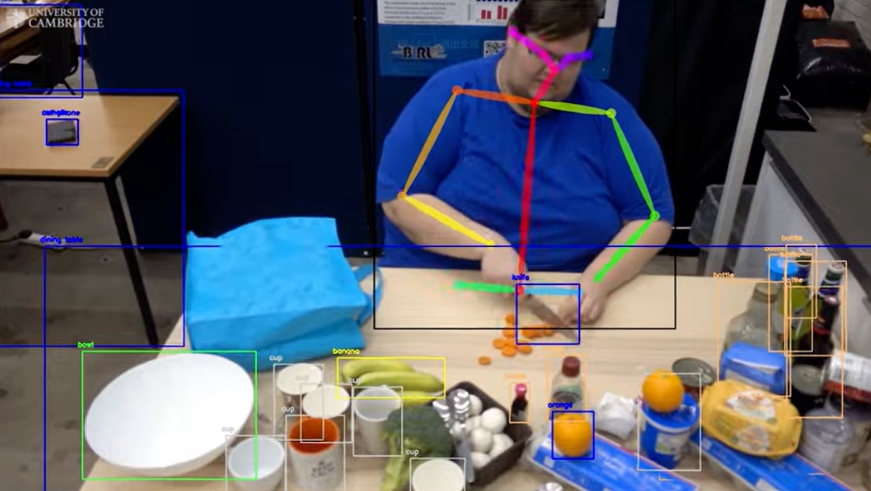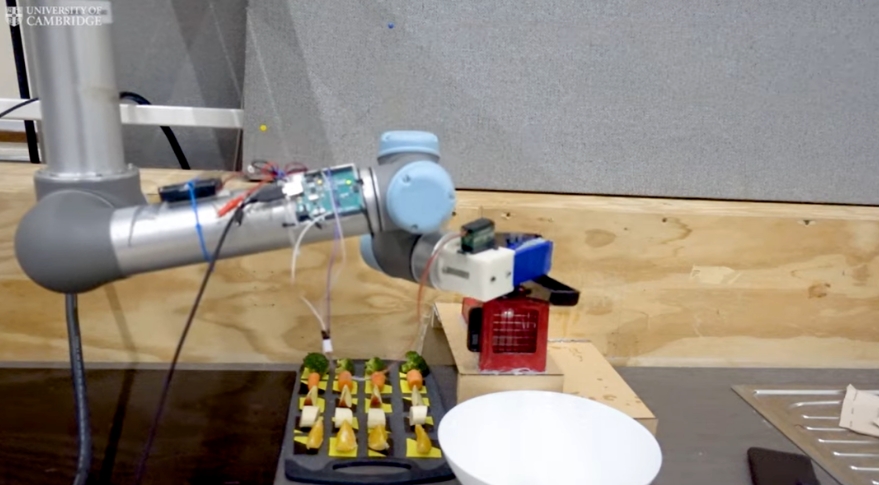Robot chef learns to recreate recipes from watching food videos
研究人员训练了一个机器人“厨师”来观看烹饪视频并从中学习重新制作菜肴。
Researchers have trained a robotic ‘chef’ to watch and learn from cooking videos, and recreate the dish itself.
来自剑桥大学的研究人员为他们的机器人厨师编写了一本包含八种简单沙拉配方的“食谱”。在观看了人类演示其中一种食谱的视频后,机器人能够识别出正在准备和制作的食谱。
The researchers, from the University of Cambridge, programmed their robotic chef with a ‘cookbook’ of eight simple salad recipes. After watching a video of a human demonstrating one of the recipes, the robot was able to identify which recipe was being prepared and make it.
此外,这些视频帮助机器人逐渐丰富自己的食谱。实验结束时,机器人自己想出了第九个菜谱。他们的研究结果发表在IEEE Access杂志上,展示了视频内容如何成为自动化食品生产的宝贵和丰富的数据来源,并且可以更轻松、更经济地部署机器人厨师。
In addition, the videos helped the robot incrementally add to its cookbook. At the end of the experiment, the robot came up with a ninth recipe on its own. Their results, reported in the journal IEEE Access, demonstrate how video content can be a valuable and rich source of data for automated food production, and could enable easier and cheaper deployment of robot chefs.
几十年来,机器人厨师一直是科幻小说的主角,但在现实中,烹饪对机器人来说是一个具有挑战性的问题。一些商业公司已经建立了原型机器人厨师,但目前还没有商用,同时它们在技能方面远远落后于人类同行。
Robotic chefs have been featured in science fiction for decades, but in reality, cooking is a challenging problem for a robot. Several commercial companies have built prototype robot chefs, although none of these are currently commercially available, and they lag well behind their human counterparts in terms of skill.
人类厨师可以通过观察学习新食谱,无论是观看另一个人做饭还是观看YouTube上的视频,但编程机器人制作一系列菜肴既昂贵又耗时。
Human cooks can learn new recipes through observation, whether that’s watching another person cook or watching a video on YouTube, but programming a robot to make a range of dishes is costly and time-consuming.

该论文的第一作者、剑桥大学工程系的Grzegorz Sochacki 说:“我们想看看是否可以训练机器人厨师以与人类相同的渐进方式学习——通过识别成分以及它们在菜肴中的搭配方式” 。
“We wanted to see whether we could train a robot chef to learn in the same incremental way that humans can – by identifying the ingredients and how they go together in the dish,” said Grzegorz Sochacki from Cambridge’s Department of Engineering, the paper’s first author.
Sochacki是Fumiya Iida教授仿生机器人实验室的博士候选人,他和他的同事们设计了八种简单的沙拉食谱,并拍摄了自己制作这些沙拉的过程。随后他们使用公开可用的神经网络来训练机器人厨师。神经网络被编程为可识别一系列不同的物体,包括八种沙拉食谱中使用的水果和蔬菜(西兰花、胡萝卜、苹果、香蕉和橙子)。
Sochacki, a PhD candidate in Professor Fumiya Iida’s Bio-Inspired Robotics Laboratory, and his colleagues devised eight simple salad recipes and filmed themselves making them. They then used a publicly available neural network to train their robot chef. The neural network had already been programmed to identify a range of different objects, including the fruits and vegetables used in the eight salad recipes (broccoli, carrot, apple, banana and orange).
通过使用计算机视觉技术,机器人分析了视频的每一帧,并能够识别不同的物体和特征,例如刀和配料,以及人类演示者的手臂、手和脸。食谱和视频都被转换为矢量,机器人对矢量执行数学运算以确定演示和矢量之间的相似性。
Using computer vision techniques, the robot analysed each frame of video and was able to identify the different objects and features, such as a knife and the ingredients, as well as the human demonstrator’s arms, hands and face. Both the recipes and the videos were converted to vectors and the robot performed mathematical operations on the vectors to determine the similarity between a demonstration and a vector.
通过正确识别成分和人类厨师的动作,机器人可以确定正在准备的食谱。机器人可以推断,如果演示者一手拿着刀,另一手拿着胡萝卜,那么胡萝卜就会被切碎。
By correctly identifying the ingredients and the actions of the human chef, the robot could determine which of the recipes was being prepared. The robot could infer that if the human demonstrator was holding a knife in one hand and a carrot in the other, the carrot would then get chopped up.
在它观看的16个视频中,机器人在93%的时间内识别出正确的食谱,尽管它只检测到83%的人类厨师的动作。机器人还能够检测到食谱中的细微变化,例如制作双份或正常人为错误是变化而不是新食谱。机器人还正确识别了第九种新沙拉的演示,将其添加到食谱中并进行了制作。
Of the 16 videos it watched, the robot recognised the correct recipe 93% of the time, even though it only detected 83% of the human chef’s actions. The robot was also able to detect that slight variations in a recipe, such as making a double portion or normal human error, were variations and not a new recipe. The robot also correctly recognised the demonstration of a new, ninth salad, added it to its cookbook and made it.
Sochacki说:“机器人能够检测到如此细微的差别,这真是令人惊讶。” “这些食谱并不复杂——它们本质上是切碎的水果和蔬菜,但它在识别方面非常准确,例如,两个切碎的苹果和两个切碎的胡萝卜与三个切碎的苹果和三个切碎的胡萝卜是相同的食谱。”
“It’s amazing how much nuance the robot was able to detect,” said Sochacki. “These recipes aren’t complex – they’re essentially chopped fruits and vegetables, but it was really effective at recognising, for example, that two chopped apples and two chopped carrots is the same recipe as three chopped apples and three chopped carrots.”

用于培训机器人厨师的视频不像一些社交媒体网红制作的食物视频那样充满了快速切换和视觉效果。例如,如果人类演示者的手缠绕在胡萝卜上,机器人将很难识别出胡萝卜——为了让机器人识别出胡萝卜,人类演示者必须举起胡萝卜,这样机器人才能看到整个蔬菜。
The videos used to train the robot chef are not like the food videos made by some social media influencers, which are full of fast cuts and visual effects, and quickly move back and forth between the person preparing the food and the dish they’re preparing. For example, the robot would struggle to identify a carrot if the human demonstrator had their hand wrapped around it – for the robot to identify the carrot, the human demonstrator had to hold up the carrot so that the robot could see the whole vegetable.
Sochacki说:“我们的机器人对社交媒体上风靡一时的美食视频不感兴趣——它们太难理解了。” “但随着这些机器人厨师在识别食物视频中的成分方面变得越来越好、越来越快,他们或许能够使用 YouTube 等网站来学习各种食谱。”
“Our robot isn’t interested in the sorts of food videos that go viral on social media – they’re simply too hard to follow,” said Sochacki. “But as these robot chefs get better and faster at identifying ingredients in food videos, they might be able to use sites like YouTube to learn a whole range of recipes.”
这项研究得到了Beko plc和工程与物理科学研究委员会 (EPSRC) 的部分支持,该委员会是英国研究与创新署 (UKRI) 的一部分。
The research was supported in part by Beko plc and the Engineering and Physical Sciences Research Council (EPSRC), part of UK Research and Innovation (UKRI)

 中文
中文 English
English
